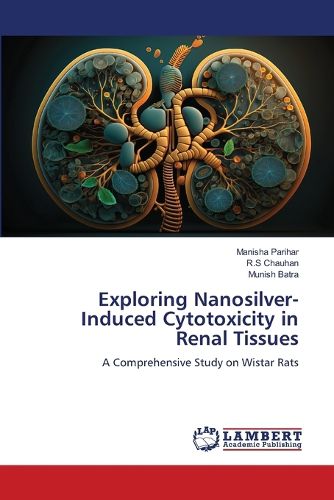Readings Newsletter
Become a Readings Member to make your shopping experience even easier.
Sign in or sign up for free!
You’re not far away from qualifying for FREE standard shipping within Australia
You’ve qualified for FREE standard shipping within Australia
The cart is loading…






This title is printed to order. This book may have been self-published. If so, we cannot guarantee the quality of the content. In the main most books will have gone through the editing process however some may not. We therefore suggest that you be aware of this before ordering this book. If in doubt check either the author or publisher’s details as we are unable to accept any returns unless they are faulty. Please contact us if you have any questions.
This study examined the nephrotoxic effects of silver nanoparticles (AgNPs) in Wistar rats over 90 days. A total of 35 rats were divided into control (20 rats) and AgNPs-treated (15 rats) groups. The treated group received AgNPs orally at 30 mg/kg body weight daily. Serum biochemical analysis showed a significant increase in creatinine, urea, uric acid, and potassium levels in treated rats, indicating impaired kidney function. Oxidative stress markers, such as increased TBARS levels and reduced CUPRAC antioxidant activity, were observed in kidney tissues. Apoptosis percentage was significantly higher in treated rats at 30, 60, and 90 days, suggesting caspase pathway activation. Urinary analysis revealed progressive proteinuria. Histopathological examination of treated rats showed glomerular congestion, Bowman's capsule damage, tubular necrosis, and interstitial hemorrhages. Immunoperoxidase staining confirmed immune complex deposition in the glomeruli, indicating immune-mediated glomerulonephritis. These findings suggest that prolonged exposure to AgNPs at 30 mg/kg is nephrotoxic, leading to kidney dysfunction, oxidative stress, apoptosis, and immune-mediated kidney damage.
$9.00 standard shipping within Australia
FREE standard shipping within Australia for orders over $100.00
Express & International shipping calculated at checkout
This title is printed to order. This book may have been self-published. If so, we cannot guarantee the quality of the content. In the main most books will have gone through the editing process however some may not. We therefore suggest that you be aware of this before ordering this book. If in doubt check either the author or publisher’s details as we are unable to accept any returns unless they are faulty. Please contact us if you have any questions.
This study examined the nephrotoxic effects of silver nanoparticles (AgNPs) in Wistar rats over 90 days. A total of 35 rats were divided into control (20 rats) and AgNPs-treated (15 rats) groups. The treated group received AgNPs orally at 30 mg/kg body weight daily. Serum biochemical analysis showed a significant increase in creatinine, urea, uric acid, and potassium levels in treated rats, indicating impaired kidney function. Oxidative stress markers, such as increased TBARS levels and reduced CUPRAC antioxidant activity, were observed in kidney tissues. Apoptosis percentage was significantly higher in treated rats at 30, 60, and 90 days, suggesting caspase pathway activation. Urinary analysis revealed progressive proteinuria. Histopathological examination of treated rats showed glomerular congestion, Bowman's capsule damage, tubular necrosis, and interstitial hemorrhages. Immunoperoxidase staining confirmed immune complex deposition in the glomeruli, indicating immune-mediated glomerulonephritis. These findings suggest that prolonged exposure to AgNPs at 30 mg/kg is nephrotoxic, leading to kidney dysfunction, oxidative stress, apoptosis, and immune-mediated kidney damage.